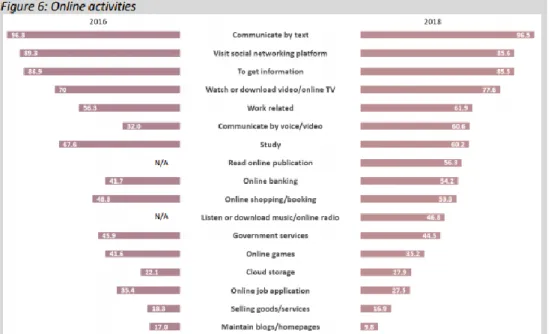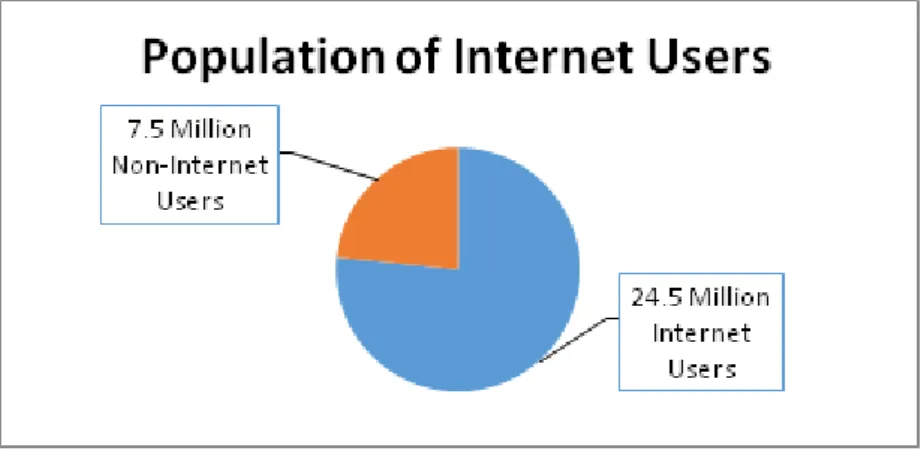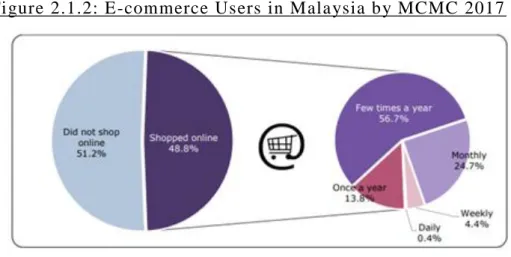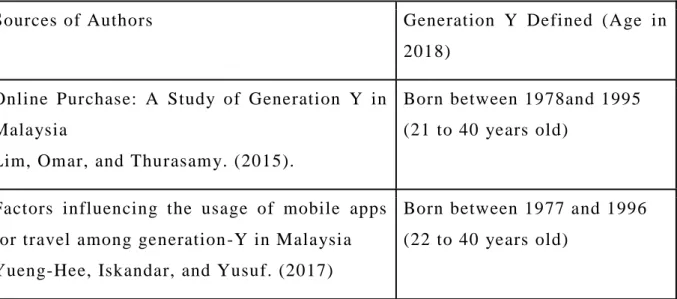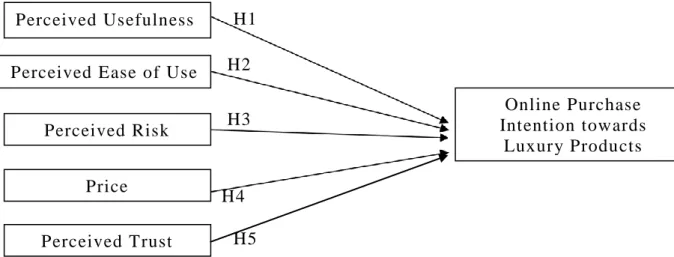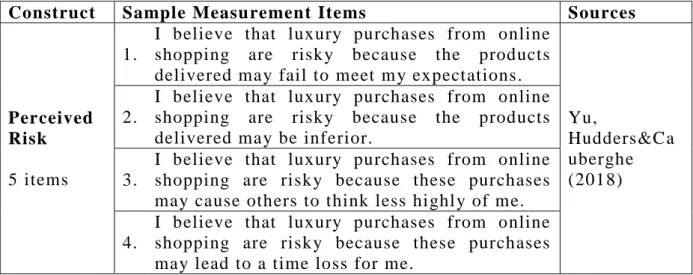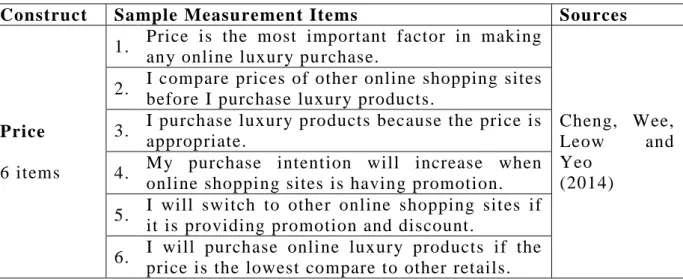However, the trend of online shopping for luxury products in Malaysia is still very slow. The purpose of this study is to investigate factors influencing the intention to shop online for luxury products among Generation Y in Malaysia.
Introduction
- Introduction
- Background of Study
- Problem Statement
- Research Objective
- General Objective
- Specific Objective
- Research Question
- Hypothesis of the Study
- Significance of the Study
- Chapter Layout
- Conclusion
H1: There is a positive relationship between PU and Generation Y's online purchase intention for luxury products. This chapter provides an overview by highlighting the issues that influence Generation Y's online purchase intention for luxury products in Malaysia.
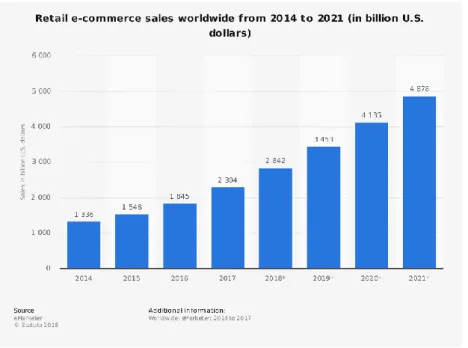
Literature Review
- Introduction
- Review of Literature
- Technology Acceptance Model (TAM)
- Internet Usage
- Generation Y
- Online Shopping
- Luxury Products
- Perceived of Usefulness
- Perceived Ease of Use
- Perceived Risk
- Price
- Perceived Trust
- Purchase Intention
- Conceptual Theoretical Framework
- Hypotheses Development
- Conclusion
Five factors are proposed to assess the issues that could influence Generation Y's online shopping intention regarding luxury products in the context of Malaysia. This study provides deeper insight and information on the above matter for companies and researchers to better understand Generation Y's online shopping intention regarding luxury products.
Methodology
Introduction
Research Design
Data Collection Method
- Primary Data
Sampling Design
- Target Population
- Sampling Frame and Sampling Location
- Sampling Elements
- Sampling Technique
- Sampling Size
Research Instrument
- The Purpose of Using Questionnaire
- Questionnaire Design
- Pilot Study
Construct Measurement
- Origin of Construct
- Measurement of Scale
Data Processing
- Questionnaire Checking
- Data Editing and Fixing
- Data Coding
- Data Transcription
- Data Cleaning
Data Analysis
- Descriptive Analysis
- Reliability Analysis
- Inferential Analysis
- Pearson’s Correlation Coefficient Analysis
- Multiple Regression Analysis
Conclusion
Data Analysis
Introduction
Chapter four presents the analysis and findings gathered from the online questionnaire created in Google Form. The evaluation was based on the assessment of descriptive analysis, reliability test and finally inferential analysis.
Pilot Study
Data Collection
Descriptive Analysis
- Demographic Profile of Respondents
The majority of respondents are in the age group from 21 to 25 years, namely 66.2%, and the least are in the group from 31 to 35 years, namely 5.6%. These other racial groups consisted of Eurasian, Japanese, Kadazan, Kenyan, Korean, Portuguese and also Rungus racial groups. The racial group with the largest number of respondents in this survey is Chinese, at 10.3%.
The percentage of respondents who are single is out of respondents who are married and 0.5% of respondents are divorced or widowed. The group of respondents with a university degree contributed the most to the survey with 6.1% and the least with only 3.8% of respondents with postgraduate education. The profession group with the largest number of respondents are students with 58.2% and the profession group with the fewest respondents are pensioners with only 0.5%.
The number of respondents earning less than RM1,500 as their personal income or allowance is the highest at 59.2% and the number of respondents earning between the range of RM3,001 to RM4,500 is the lowest at 5.6%.
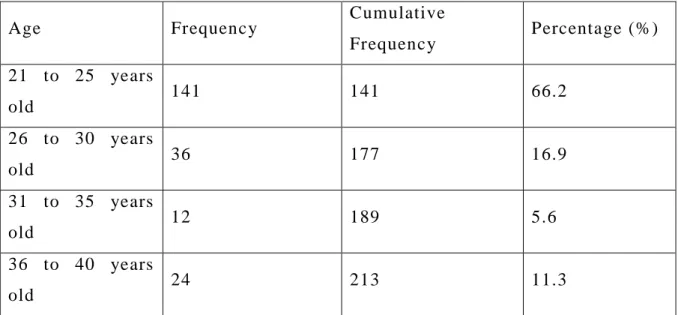
Luxury Products
- Purchase Intention of Luxury Products
- Type of Luxury Products Purchased
- Online Purchase Channel
- Frequency of Online Shopping for Luxury Products
125 respondents buy technology gadgets, 122 buy fashion products, 41 buy luxury accessories, 54 buy Boutique brands, 29 buy Prestige brands and 78 buy food and beverages. Technology gadgets are most preferred online at 27.8% and the least preferred type of luxury product purchased online is Prestige brands at 6.5%. Other types of luxury products also purchased online by the respondents are plant, pet products, auto accessories, clothing, cooking appliances, skin cleansing products, handicrafts, skin care and also cosmetics which made up the remaining 0.5% of the respondents.
Most respondents preferred Lazada with a total of 31.3% and the least preferred online shopping channel is 11Street with 4.8%. Other online shopping channels used by the respondents are the retailer's website (such as Instagram or Facebook), Zalora and Farfetch made up the rest of the respondents.
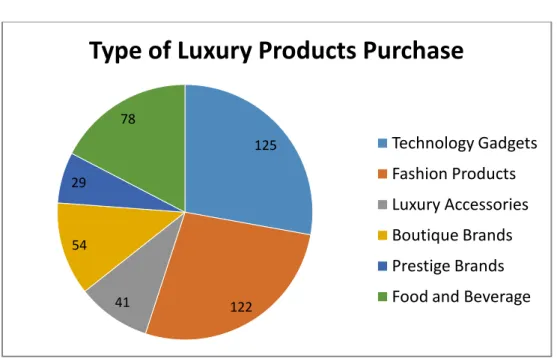
Measurement Model
- Data Reliability
Inferential Analysis
- Pearson Correlation Coefficient
- Multiple Regression Analysis
There is a strong positive relationship between online luxury purchase intention and PU (0.713) among other variables. R squared is shown as estimated at 0.596; where the regression of online purchase intention on luxury products is estimated at 0.772. This means that there is 60 percent of the variance of the dependent variable, online purchase intention for luxury products, that can be explained by the independent variables.
The low R-square can be attributed to the limited behavioral aspect used in this research, as many types of human behavior contribute to purchase intention. Findings indicate that the regression model is able to account for a significant amount of the variance in online purchase intention toward luxury products using the independent variables of PU, PEOU, PR, price, and PT. The regression coefficient is able to explain the extent of each independent variable's effect on the dependent variable when all other independent variables are held constant.
This translates that when a score in PU, PEOU, price and PT increases and the score of online purchase intention towards luxury products will increase by and 0.295 respectively. The finding shows that PU has the greatest influence on online purchase intentions related to luxury products, as it has the highest unstandardized coefficient value of 0.414 among the five variables. This means that PU makes the strongest unique contribution to explaining the influence of online purchase intentions towards luxury products.
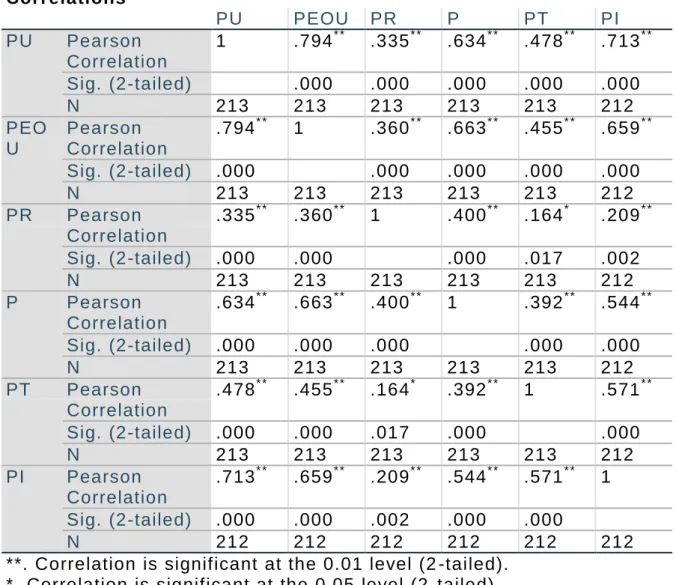
Conceptual Framework
- Testing of Hypotheses
Conclusion
Discussions, Conclusion and Implication
Introduction
Discussion of Major Findings
- Findings on the Hypotheses
The higher the consumer's perception of usefulness in online platforms, the more likely consumers are to have an online purchase intention toward luxury products. The hypothesis of the results is confirmed to be similar to the results obtained from a literature done by A shraf et al (2014) and Renny et al (2012), which showed that PEOU is positively related to online purchase intention of consumers. The higher the consumers' PEOU (Renny et al, 2012), the more likely consumers will develop online purchase intention towards luxury products.
In this research, an increase in PR does not decrease Gen Y's online purchase intention towards luxury products. Therefore, Gen Y consumers with more online experience have a higher online purchase intention towards luxury products despite the higher risk in product value. That is, Gen Y online shopping targeting luxury products may care less about price as their perception of high price is an indicator of quality.
Therefore, in this research, Generation Y's online purchase intention regarding luxury products is not related to the high price of luxury products, as they are willing to pay more in exchange for high quality products. Ashraf et al (2014) and Marroitt and Williams (2018) mentioned trust as an important variable that can have a consequential effect on consumers' online purchase intention. The more consumers trust an online shopping platform, the higher the consumer's intention to purchase luxury products online.

Implications of the Study
This means that consumers must have developed a positive trust in online retailers regarding their ability to deliver products and services. If the retailer fails to deliver the element of trust, consumers' online purchase intention from that retailer will decrease (Marroitt and Williams, 2018). Therefore, an increasing result in PT can be achieved by establishing reliability, credibility, honest terms and a secure website to shift consumers' perception of purchase intention of luxury products from brick-and-mortar stores to online stores.
72 Managers and online retailers need to improve the effectiveness of their online shopping website to provide convenience and facilitate the Generation Y's purchasing activities, thereby attracting them to increase their spending on luxury products online. Online retailers should also provide useful detailed product descriptions such as size dimensions, weight, practical uses and warranty along with clear photos of their luxury products to help them make important purchasing decisions. Regarding PEOU, Generation Y tends to purchase luxury products online when the online shopping sites provide useful features to help them make the purchase decision of luxury products.
Therefore, online retailers should design their online shopping website by providing easy and understandable features and provide sequential information that appeals to Generation Y's online luxury shopping needs and optimize the online shopping website on various devices that Generation Y will most likely use regularly for online luxury purchasing. Luxury products are priced at a high price, making the consumers more cautious about their purchase decision for fear of being cheated, especially when the luxury purchase is made on untrustworthy online shopping sites. Therefore, to improve trust among Generation Y, online retailers must ensure that they provide guaranteed secure transactions for luxury purchases protected by multiple security policies and build a strong customer service team that quickly meets the needs of Generation Ys.
Limitations of the Study
73 Generation Y, but had a major impact on other groups of consumers, such as Generation Z, who may be more engaged in online shopping compared to Generation Y. It is possible that other groups of consumers are also more likely to switch to online luxury purchases compared to Generation Y. Although an online questionnaire facilitates the distribution of the questionnaire for the researchers, distributing paper questionnaires is preferable to approaching the intended respondents directly.
Conducting timely research, which allows researchers to collect reliable and valid data, is important to ensure the success of the study. Researchers may be forced to collect a limited amount of results without being able to see any changes in trends that may affect the data collected. Consequently, the trend of intent for online luxury purchases may improve or decline in the coming months.
Therefore, a longer time frame is preferable when conducting the research to collect more meaningful and accurate results.
Recommendations for Future Research
The current research is limited to Generation Y only, by expanding it to other generations, it allows researchers to better understand the intention to purchase luxury products online. In addition, it would allow the respondents to understand the questions, which would increase the accuracy and precision of the results.
Conclusion
Applying the technology acceptance model in different cultural contexts: The case of online shopping adoption. My Market Research Methods. Retrieved 2018, November 1, from:. https://www.m ymarketresearchmethods.com/types-of-data-nominal- ordinal-interval-ratio/. Women: Who is more active on social media. Retrieved November 11, 2018, from: https://www.brand watch.com/blog/men-vs-women-active-social-media/. Impulse buying: Gen-Y faces online shopping debt trap.
Malaysia. Retrieved 2018, November 18, from: https://ieeexplore-ieee- org.libezp2.utar.edu.my/document/8409238/authors#authors. 2014). FACTORS AFFECTING GENERATION Y„S ONLINE BUYING CONSIDERATIONS IN THE BOOK INDUSTRY. Retrieved 2018, November 1, from: http://eprints.utar.edu. Study on the factors affecting online shopping intentions for luxury products among Generation Y in Malaysia.
We are conducting a research project on "A Study on Factors Influencing Online Shopping Intention to Luxury Products among Generation Y in Malaysia". Online shopping sites offer useful features to help me make the decision to purchase luxury products. I will switch from physical retail stores to online shopping sites if it offers promotion and discounts on luxury products.
